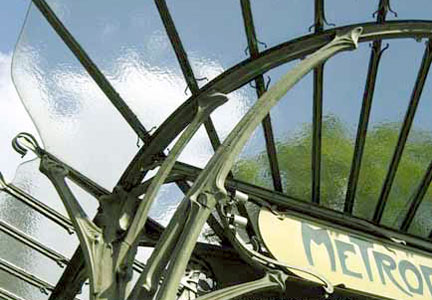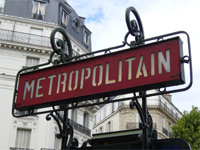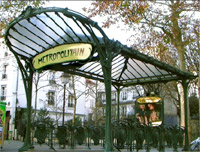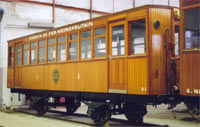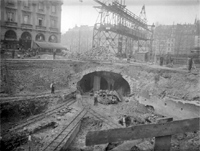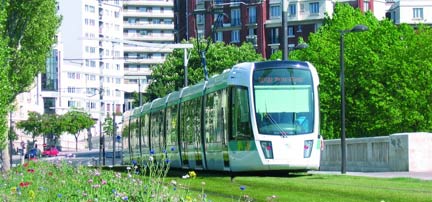Paris has Métro Style
by Marco Chown Oved
Article published on the 2009-02-20 Latest update 2009-02-26 09:46 TU
Culture in France: Paris Métro Style
From the famed iron-and-glass Art Deco entrances, to the elevated sections of track that elegantly swoop over the boulevards, images of the Métro have become synonymous with Paris itself.
A newly-released book, Paris Métro Style tells the tory of the system from its inception at the turn of the century, through its various bureaucratic and technological evolutions to the modern, yet still elegant, service that exists today.
The book is the product of a chance encounter between a Frenchman and an Englishman while exploring the catacombs under Paris. Mark Ovenden is a British-born historian and writer whose interest in urban transport had already produced another book, Metro maps of the world.
Julian Pepinster is a French-born Métro enthusiast, who works in its safety department. He is also president of ADEMAS, a non-profit organisation dedicated to the preservation and promotion of the history of the Paris Métro.
They started the book by researching and compiling historic maps of the Métropolitain, collecting old advertisements and photos, drawn to the style that makes Paris's Métro unique. Reflecting this emphasis, the cover of the book shows a detail of the beautiful wrought iron and glass Metro entrance at Porte Dauphine.
Ovenden explains that these entrances, designed by Hector Guimard, “are almost universally known around the world. If you were to show someone that entrance, they would say, 'Paris Métro'.”
The Art Deco form was intended to reflect natural, organic forms. “If you look at the legs and the structure, it looks like a flower or a branch or a tree,” says Ovenden. “Unfortunately some of the most grandiose buildings didn't survive. They were knocked down in the 50s and 60s.”
The glossy coffee-table book doesn't only have beautiful photos and historic maps, it deals with technological developments of trains and track as well.
Because the Paris system was built relatively late - decades after London and New York - it avoided the mistakes made in other cities. When the first Paris stations opened in 1900, the entire system was underground and electric, contrasting with London, where the system that opened its doors in 1863 used underground steam engines, and New York where, in 1868, long viaducts and elevated trains robbed the streets of sunshine.
The Métro was built to be hygienic, Pepinster explains, and this obsession with cleanliness led, perhaps unintentionally, to the unique style we see today. “People were worried about getting ill going underground where so many dirty things are buried. So nice white tiling, which could be disinfected easily, was put on the walls,” Pepinster says.
Competition between the North-South Company and the CMP, the Chemin de fer Métropolitain de Paris, produced a frantic construction rate and a need to seduce a reluctant public. “In the 1910s, a private company [Nord-Sud] made very nice designs of trains and stations,” says Pepinster. “Logically, the city-owned system became nicely decorated just to match what the private people had done.”
Following this initial building phase, very little new infrastructure was built. Delayed by the two World Wars, the system would keep its distinctly turn-of-the-century feel.
“The inner-Paris system is how history has left it to us in the late 30s”, says Pepinster.
The RER was the first major renovation of the transport system. Built in the 1960s, it introduced a suburban rail link to complement the metro, bringing people into the city faster than a metro could, and inter-linking with the metro system so that passengers could then get precisely to where they were going in town.
“France takes the biscuit when it comes to the world's investment in transport”, says Ovenden. “Crossing the centre of the city deeper than the metro and linking the very far suburbs is the envy of the world. Every other major city wants to do it. And even London – which is, 60 years later, finally going to build a cross-rail system – is saying, 'well, we should have done what France did.'”
Now, at the turn of the 21st Century, Paris is again seeing a newfound interest in the metro and has again started investing in new lines and services. It's a second renaissance, Ovenden says, a “21st Century organic, 'let's look after the environment' renaissance, where they're now thinking about tramways, renovating all the railways, connecting parts of the greater Paris area that haven't been connected before.”
The RATP, which runs the Metro and parts of the RER, hasn't lost the original spirit of the Paris system. The planners, “have very bold ideas for creating new public spaces which are aesthetically pleasing and functional”, Ovenden says. “That's coming across [in] the latest stations that are being opened, and from the tramway. The tramway in Paris is absolutely beautiful. It's grassed-overed in places and it's environmentally-friendly. People have taken to it very quickly.”
“The future will see lots of building on the traditions of success,” he says. “Now there is a real understanding that you have to make public transport attractive in order to get people out of their cars, leave their cars at home, do the right thing and use public transport to get around the city.”
------------------------------------------------------------------------------------------------------
Paris Métro Style, by Mark Ovenden, edited by Julian Pepinster and Peter B. Lloyd. Published by Capital Transport, London, 2008. Soon available in French.
Culture
Cracking skulls!
2010-02-15 12:35 TU
France's gothic avant-garde
2010-02-13 15:16 TU
Winter sounds warm up French jazz fans
A tribute to trumpeter Don Cherry at a Free Jazz showcase festival outside of Paris.
2010-01-31 11:55 TU
Trance on a trapeze
2010-01-30 12:41 TU
Retro Mobile - classic car exhibition
260,500 euros for rusty old car found at bottom of lake
A rusty old Bugatti, which spent years at the bottom of a Swiss lake, sold for 260,500 euros at the Retro Mobile classic car exhibition on Saturday. Other more lovingly-restored pristine examples are exciting enthusiasts from across the world in a special anniversary event at Porte de Versailles in Paris.
2010-01-23 20:21 TU
France's changing face looks east
2010-01-22 16:17 TU
Putting art on film
2010-01-20 13:09 TU
What sex is a coffee bean, where does the aubergine come from?
2010-01-08 16:08 TU
Cocteau Twin flying solo
2010-01-06 16:43 TU
A taste of Nordic filmmaking in Paris
Ciné Nordica 2009 at Paris’s Panthéon cinema showcases filmmaking from Scandinavia. So what makes Nordic film different from the rest?
2009-12-22 17:15 TU




